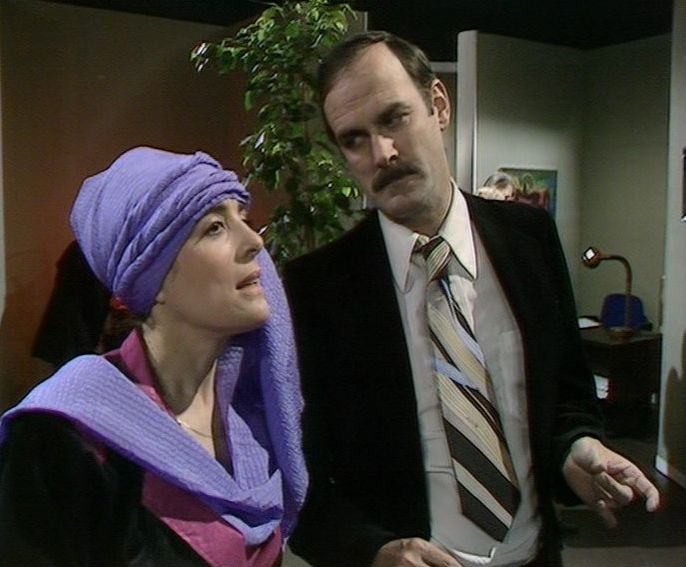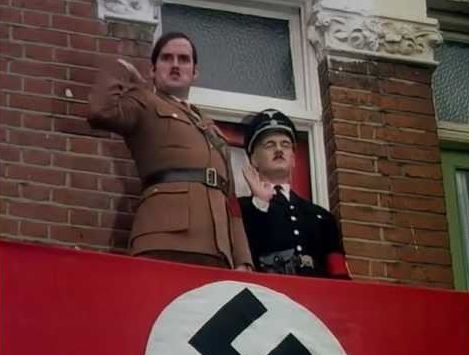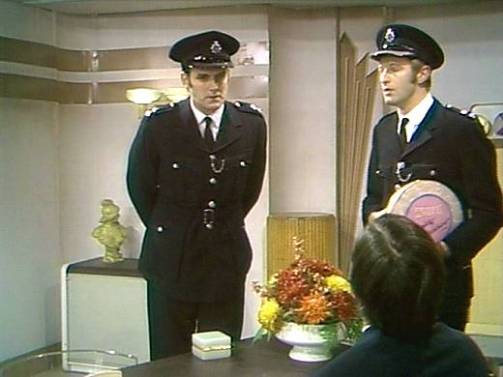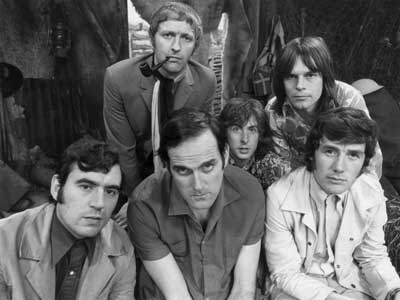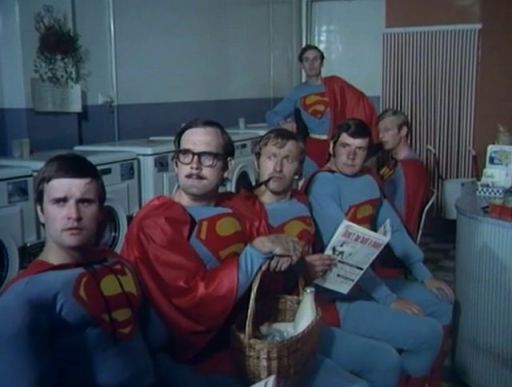
Background
Broadcast in 1967 on ITV (Rediffusion London) At Last The 1948 Show is one of a handful of shows which laid the groundwork for Monty Python’s Flying Circus (Do Not Adjust Your Set is another key pre-Python programme which I’ll be taking a look at next week).
Earlier in the sixties, John Cleese, Graham Chapman and Tim Brooke-Taylor had been part of the Cambridge Footlights team who took the revue A Clump of Plinths/Cambridge Circus first to the Edinburgh Festival and then onto the West End, Broadway and a tour of New Zealand. Some of the best of their revue material would later be pressed into service in At Last The 1948 Show.
Cleese and Brooke-Taylor were also integral members of the radio series I’m Sorry I’ll Read That Again from 1964 whilst Cleese and Chapman also kept busy writing for The Frost Report. Feldman was another key Frost Report contributor (he co-wrote the Class sketch which featured Cleese, Ronnie Barker and Ronnie Corbett). And like the others, Feldman was also enjoying considerable radio success (co-writing Round The Horne with Barry Took).
David Frost was something of a television powerhouse during this period. Although he would be the subject of harsh (but loving?) ridicule in both At Last The 1948 Show and Python, there’s no denying that he pushed the careers of many of his contemporaries forward (something which both Cleese and Brooke-Taylor are happy to acknowledge today).
Produced by Frost’s company Paradine Productions, At Last The 1948 Show ran for two series in 1967 (six episodes during February and March with a further seven following between September and November). Joining the four writers and performers was the lovely Aimi MacDonald who managed to wring the absolute maximum out of the small amount of material she was given.
Although At Last The 1948 Show had a more convential format than Python (sketches with punch-lines for instance) MacDonald’s fractured linking material does echo the way that Terry Gilliam’s animations would later be used in Python to provide a brief interlude between the sketches.
The likes of Bill Oddie, Barry Cryer and Eric Idle also pop up from time to time (Cryer having the smallest of small parts in probably the most famous sketch the series produced – Four Yorkshiremen).
Archive Status
Like a great many shows made during the sixties and early seventies, most of At Last The 1948 Show was wiped during periodic archive purges. By the time that the remaining Rediffusion archive was donated to the BFI, it was found that only two episodes (four and six from series one) remained. That most of the series now exists is testament to the tenacity of several key people (notably Steve Bryant and Dick Fiddy).
The first breakthrough was the return in 1990 of five compilation programmes broadcast in Sweden (these were issued on DVD in 2007). Over time, several other shows were also located whilst fragments of footage have been obtained from disparate sources which include the Australian censor and Marty Feldman’s widow, Lauretta.
Most recently, two virtually complete editions (including series one, show one) were donated from Sir David Frost’s archive. For this release, where no video footage exists (the second episode of series one is the most incomplete) off-air audio has been synchronised to the camera script in order to fill the gaps.
The Series
Right from the off, the comic personas of the four main players are deftly established. John Cleese displays the type of manic intensity which would be his signature performance style for the next decade or more. Graham Chapman has a nice line in authority figures (albeit ones who have some fatal flaw – such as the Minister who literally falls to pieces). It also has to be said that he gives good yokel.
Tim Brooke-Taylor is always perfect as the hapless sufferer but also, like Cleese, does manic intensity very well. His clockwork hospital visitor (attempting to comfort a bed-bound Bill Oddie) is a wonderfully energetic spot of nonsense.
And although Marty Feldman had far less performing experience than the others, he impresses right from the off. His boggle-eyed stare (something which David Frost thought would be offputing for the viewers) means that he’s perfect casting as the more eccentric characters, although he’s equally able to play the straight man when required.

Series one is stuffed with memorable sketches, a number of which were later recycled by the Pythons. For example, in the first show we see Graham Chapman’s solo wrestler in addition to the Secret Service sketch (which later appeared on the Python’s Live at Drury Lane album).
The Undercover Policeman sketch in show four is a delightfully ramshackle piece which saw all four struggle (and fail) to keep a straight face. In his interview on the third disc, Brooke-Taylor fills in some of the background – what was transmitted appears to be a second take and the others, for whatever reason, decided to devitaite from the script the second time around. This initially leaves Tim a little at sea ….
Several of the Cleese/Feldman two-handers, especially the bookshop sketch (Feldman as a customer requesting more and more unlikely books, Cleese as the increasingly ticked off proprtieter) are top notch. This one was recycled several times, both by Feldman and the Pythons, but the original is hard to beat. The Wonderful World of the Ant is another which gets the thumbs up from me.
I also like the way that the hostesses increase by one each week, meaning that by the sixth and final show there are half a dozen glamourous girls all vying for attention. The lovely Aimi always comes out on top though.
She has a slightly increased role in the second series, which continued very much in the vein of the first. Highlights include the period drama The Willets of Littlehampton and Tim Brooke-Taylor’s fairly savage parody of David Frost (The Marvin Bint Programme). The Four Yorkshiremen sketch is the undoubted jewel of show six, but Tim Brooke-Taylor’s chartered accountant dance is also worthy of a mention.
The seventh and final show has another classic Cleese/Feldman sketch and whilst it’s a shame that this edition isn’t quite complete (the final skit – a performance of The Rhubarb Tart Song – is missing) at least the end credits (which feature Ronnie Corbett gatecrashing proceedings to trail his new show) do still exist.
Special Features
The three disc set contains a generous amount of supplementary content. Copies of the two scripts which feature the most missing material are included on the first two discs, along with a handful of other brief features.(such as photo galleries and John Cleese’s 2003 introduction from the BFI Missing Believed Wiped event).
The bulk of the special features are on the third disc. Two newly shot interviews with John Cleese (31 minutes) and Tim Brooke-Taylor (38 minutes) are both of interest.
Cleese’s comments on his increasingly distant relationship with Feldman and his fondness for performing with Brooke-Taylor (who he likens, in performance style, to Michael Palin) were a few highlights from his interview whilst it’s hard not to love the all-round good egg that is Tim Brooke-Taylor. Indeed, rather like Michael Palin it’s difficult to imagine anyone ever having a bad word to say about him.
Also included is a 2006 interview with Cleese at the BFI (36 minutes) and 25 minutes of rushes from a 1969 interview with Marty Feldman which was never broadcast. Several audio features – Reconstructing At Last The 1948 Show (44 minutes) and a chaotic Dee Time interview (12 minutes) are also worthy of investigation.
Picture Quality
The previous DVD release (of the Swedish compilations) was incredibly grotty so any upgrade would have been welcome. The picture quality is certainly much improved, although given that several episodes were patched together from various sources it’s not surprising that some sections look better than others.
Given the age and condition of the telerecordngs, there may have only been a finite amount of restoration work which could have been carried out. So you can expect to see tramlining and other picture defects from time to time. But these are only intermittent issues, so in general the picture quality is quite acceptable.
Conclusion
Whilst At Last The 1948 Show will probably always be viewed as a son of Monty Python, it’s a series that really deserves to be appreciated on its own merits. Like every sketch show it doesn’t have a 100% strike rate, but when it clicks (as it so often does) the results are simply glorious.
It’s also very pleasing that after a great deal of hard work by the BFI, we have the series reconstructed in as complete a form as possible. Together with a raft of impressive contextual extras, it results in a very impressive package which comes highly recommended.









